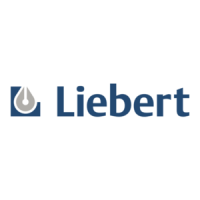9.5 Condensate-drain and Condensate-pump System Maintenance
9.5.1 Condensate Drain
Check for and clear obstructions in tubing during routine maintenance.
9.5.2 Condensate Pump
WARNING! Risk of electric shock. Can cause injury or death. Open all local and remote electric
power-supply disconnect switches and verify that power is Off with a voltmeter before working
within the condensate pump electrical connection enclosure. The Liebert iCOM™ does not
isolate power from the unit, even in the “Unit Off” mode. Some internal components require and
receive power even during the “Unit Off” mode of the LiebertiCOM.
To maintain the condensate pump:
1. Disconnect power to the unit using the disconnect switch.
2. Check for and clear obstructions in gravity lines leading to the condensate pump.
3. Remove the sump, clean with a stiff nylon brush and flush with water.
4. Inspect and clear clogs in the discharge check valve and float mechanism.
5. Reassemble and check for leaks.
9.6 Air-Cooled Condenser and Drycooler Maintenance
Restricted airflow will reduce operating efficiency and could result in high compressor-head pressure and
loss of cooling.
• Clear coil surface of all debris that will inhibit airflow.
• Check for bent or damaged coil fins and correct.
• Do not permit snow to accumulate around or under outdoor unit.
• Periodically consider commercial cleaning of coil surface
• Inspect fans, motors and controls for proper operation.
• Check all piping and capillaries for proper support.
• Inspect for leaks.
• Check contactors for pitting. Replace if pitted.
9.7 Electric Reheat Maintenance
• Inspect and clean reheat elements.
• Inspect and tighten support hardware.
9.8 Thermostatic Expansion Valve (TXV) Maintenance
The TXV performs one function: It keeps the evaporator supplied with enough refrigerant to satisfy load
conditions. It does not affect compressor operation.
Proper valve operation can be determined by measuring superheat. The correct superheat setting is
between 10 and 20°F (5.5 and 11°C). If too little refrigerant is being fed to the evaporator, the superheat will
be high. If too much refrigerant is being supplied, the superheat will be low.
Vertiv | Liebert® PDX™ and PCW™ Installer/User Guide | 83

